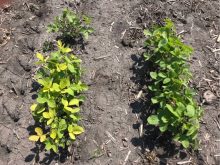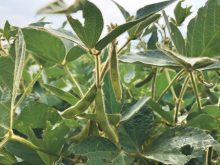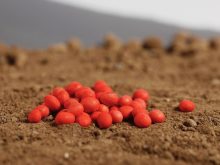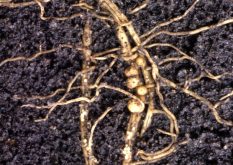It’s not exactly a household name, but iron deficiency chlorosis (IDC) can pose a serious threat to soybean producers on the Prairies.
IDC is a nutrient deficiency that can cause yellowing of soybean foliage and stunt plant growth. In extreme cases, it can lead to significant yield losses.
The problem typically develops in fields where levels of carbonate and salt impede the soybean plant’s ability to draw iron from the soil. This deficiency limits chlorophyll production, which results in the yellowing of plant tissue.
Read Also

Claas brings 1000 Series SP forage harvesters to Canada
In mid-August, Claas unveiled its new line of Jaguar forage harvesters at an event in Visalia, California, deep in the heart of that state’s dairy region.
Dennis Lange, the provincial pulse and soybean specialist with Manitoba Agriculture, says IDC is generally not a major concern if it occurs early in a soybean plant’s development, such as the second or third trifoliate stage (V2 or V3), and is followed soon after by warm growing conditions.
However, it can be far more lethal if conditions remain cool and wet and the iron deficiency persists into the fourth or fifth trifoliate stage. That’s when interveinal chlorosis (a yellowing of tissue between the veins) and necrotic damage to the plant can occur and can affect yield.
Making its presence felt
IDC has been an issue in Manitoba for more than a decade. It also has a presence in Saskatchewan, although Lange says it is far less pronounced there owing in part to fewer soybean acres. It’s also present in the U.S. Corn Belt, including North Dakota.
It can be highly variable within an area, often affecting 25 per cent or less of that field.

Lange says in-crop treatments are limited. One of the few options is an iron chelate product that can be used as part of a seed treatment package. However, he warns it provides limited benefits.
“If growers are looking to experiment with some of the iron chelate products as a seed treatment, by all means, go ahead and try those. They have been showing some good results,” he says.
“But keep in mind it’s not going to take a susceptible variety and make it more tolerant. It may take a variety that’s maybe moderate or semi-tolerant and make it a little more tolerant. But there’s a cost to that and you have to be able to justify that cost.”
Prevention best control option
Lange says prevention is the best method for controlling IDC. He recommends that soybean producers conduct regular soil testing in the fall to determine the soil’s carbonate and salt levels. This will help gauge the likelihood that IDC will develop. For example, a combination of high soluble salt (one millimhos per centimetre) and carbonate (five per cent) concentrations in the soil is an indication of extreme risk.
Once growers understand the carbonate and salt levels in their fields, Lange says they can make a more informed choice about suitable varieties.
He recommends growers compare test results with data in their provincial seed guide to determine which variety is the best fit. That includes considering IDC tolerance rather than focusing exclusively on yield.
“Over the years, I’ve had growers pick a variety and they plant it, not realizing that they have high carbonates and salt and the variety that they chose was IDC susceptible,” he says.
“All of a sudden, now you’re having a field where the plants are shorter, it’s more difficult to harvest because everything shortens up because the plants are under stress, and sometimes it’s more difficult to get those lower pods.
“To me, addressing the problem with varieties is probably a better way to go. The varieties that we have now are better than they were five years ago with respect to IDC. They’re a lot more tolerant. It’s another tool growers can use.”

If planting soybeans in an area where IDC hasn’t been present before, growers can probably choose almost any variety, Lange says. However, if planting in an area with heavier clay soil, IDC tolerance should be top of mind.
“You may want to take a closer look at your fields,” he says. “There are fields that soybeans may just not be a fit for. Maybe your salts and carbonates are just so high on a particular field that soybeans won’t perform very well there. There may be an option not to grow soybeans on that particular field.”
Another tool is an accurate and detailed history of the field.
“What I tell growers is if you find IDC in the field and it’s severe, let’s say affecting a good portion of the field, then make a note of the field, make a note of the variety that you grew.
“If you grew a semi-tolerant or susceptible variety on that particular field, the next time that field comes back to soybeans, you want to make sure you change to a tolerant variety,” he notes.
IDC is far more likely to develop in moist soil conditions, but it can also occur in a drier year. Lange says that can be a result of moisture in the soil pushing salt toward the surface. Once the moisture evaporates in drier conditions, the salt is left behind, which reduces the uptake of iron by the plant.
















